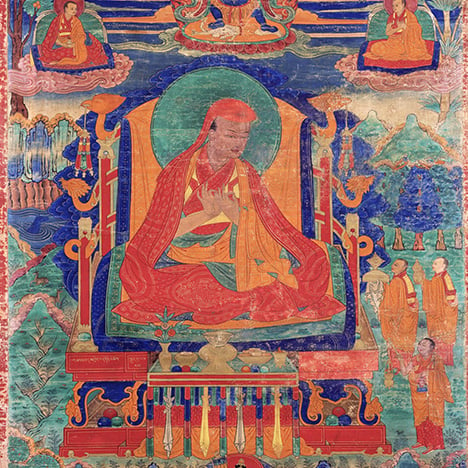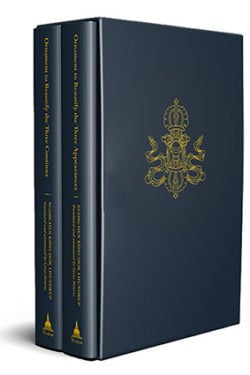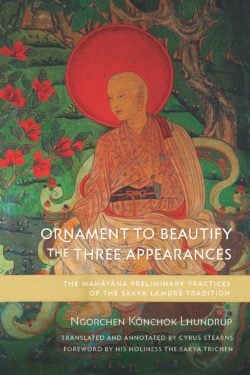Ngorchen Könchok Lhundrup

Ngorchen Könchok Lhundrup (1497–1557) was one of the greatest masters of the Sakya tradition of Tibetan Buddhism. In 1534, after years of study and meditation, he became the tenth abbot of Ngor Monastery. His many writings, especially those concerning the Lamdré teachings, are famous for their clarity and eloquence, and remain indispensable for understanding Buddhist practice and theory in the Sakya tradition today, nearly five hundred years after they were composed.
Image credit:
Lama, Ngorchen Könchog Lhundrup
Tibet; 18th century
Pigments on cloth
Rubin Museum of Art
Gift of Shelley and Donald Rubin
C2006.66.320 (HAR 722)
Books, Courses & Podcasts
The Preliminary and Main Practices of the Sakya Lamdré Tradition
This beautiful box set contains translations of two major works written by Ngorchen Könchok Lhundrup (1497–1557) to explain the teachings of the Lamdré, or Path with the Result, the most precious system of tantric theory and practice in the Sakya tradition of Tibetan Buddhism. Both volumes are translated by Cyrus Stearns with a foreword by His Holiness the Sakya Trichen. The first volume is also available as a standalone book, and the teachings within it may be practiced by anyone, without specific, required preparation. Because the second volume explains Vajrayāna practices that require specific preparation, this is a restricted box set intended only for students who have at least received the great initiation of Hevajra.
The first volume, Ornament to Beautify the Three Appearances, explains the preliminary practices of the Lamdré. The guiding instructions on impure appearance are for the purpose of developing renunciation. These focus on the defects of saṃsāra; the rarity, benefit, and transience of human life; and the nature of positive and negative actions and results. The guiding instructions on the appearance of the experiences are for the purpose of producing the altruistic intent. These focus on developing love, compassion, and bodhicitta and cultivating joy now about the uncommon experiences that will arise later when practicing the Vajrayāna teachings. The guiding instructions on pure appearance are for the purpose of producing enthusiasm for the ultimate result of complete awakening. These briefly describe the inconceivable nature of a buddha’s enlightened body, speech, and mind.
The second volume, Ornament to Beautify the Three Continua, explains the main tantric practices of the Lamdré. To study, reflect, and meditate on these, a person must first receive the Hevajra initiation and keep the sacred commitments. Three main topics are presented: the cause, the path, and the ultimate result. To understand that the abiding mode of saṃsāra is not beyond the appearances of the mind, or the universal ground (since all the phenomena of saṃsāra and nirvāṇa are complete within the mind), the causal continuum of the universal ground is taught. To understand the essence of the path that is to be practiced, the precise way to meditate is taught. Moreover, to understand that the key points of the body must be targeted, the method continuum of the body is taught. To realize the essence of the result, the level of buddhahood is determined.
Dependent on the causal continuum of the universal ground, which is like a field, being purified by the method continuum of the body, which is like water and manure, the resultant continuum of mahāmudrā (the four resultant kāyas), which is like the ripened fruit, is actualized.
The first volume from this set may be purchased as a standalone volume here.
Ornament to Beautify the Three Appearances
Ornament to Beautify the Three Appearances is the first book of a two-volume set of works written by Ngorchen Könchok Lhundrup (1497–1557) to explain the Lamdré teachings, the most important system of tantric theory and practice in the Sakya tradition of Tibetan Buddhism. This volume is translated by Cyrus Stearns with a foreword by His Holiness the Sakya Trichen.
The Lamdré, or Path with the Result, is based on the Vajra Lines of the great Indian adept Virūpa (ca. seventh–eighth centuries). The first topic is the fundamental meditative practices of Hīnayāna and Mahāyāna Buddhism. In the Lamdré teachings, these preliminary instructions are known as the Three Appearances. The guiding instructions on impure appearance are for the purpose of developing renunciation. These focus on the defects of saṃsāra; the rarity, benefit, and transience of human life; and the nature of positive and negative actions and results. The guiding instructions on the appearance of the experiences are for the purpose of producing the altruistic intent. These focus on developing love, compassion, and bodhicitta and cultivating joy now about the uncommon experiences that will arise later when practicing the Vajrayāna teachings. The guiding instructions on pure appearance are for the purpose of producing enthusiasm for the ultimate result of complete awakening. These briefly describe the inconceivable nature of a buddha’s enlightened body, speech, and mind.
Having absorbed these preliminary instructions, the practitioner may go on to the second volume of Ngorchen’s works, a restricted text that explains the main tantric practices of the Three Continua, intended for students who have at least received the great initiation of Hevajra. Volume 2 is only available in a restricted box set that includes this first volume and can only be obtained on the Wisdom Publications website. Click here to learn more about the box set.


